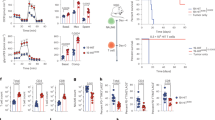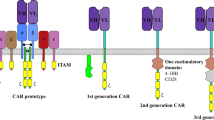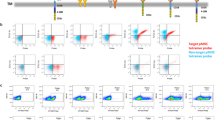Abstract
T cells can be endowed with antigen specificity by grafting with a chimeric receptor consisting of an extracellular antigen binding moiety (scFv) derived from an antibody and an intracellular signaling domain. Conflicting data exist on the impact of an extracellular spacer domain between the antigen binding and the signaling domain with respect to cellular activation. Here, we recorded conjugate formation and antigen-driven cellular activation of T cells grafted with receptor molecules that contain the same antigen binding site (anti-CD30 HRS3-scFv) and signaling domain (FcεRI γ-chain), however, with and without an IgG1 CH2CH3 (Fc) spacer domain between the scFv and transmembrane moiety. Receptors of both configurations mediate equally efficient conjugate formation between receptor grafted T cells and antigen-positive target cells. Specific signaling by the spacer containing receptor, however, is blocked by five- to 10-fold lower concentrations of soluble antigen than by the spacer-less receptor indicating a higher avidity of the spacer containing receptor to soluble antigen. In contrast, cellular activation upon binding to antigen-positive cells is mediated more efficiently by the spacer-less receptor. This demonstrates that the extracellular spacer domain impairs antigen-dependent cellular activation by the chimeric immune receptor, but not intercellular conjugate formation.
This is a preview of subscription content, access via your institution
Access options
Subscribe to this journal
Receive 12 print issues and online access
$259.00 per year
only $21.58 per issue
Buy this article
- Purchase on Springer Link
- Instant access to full article PDF
Prices may be subject to local taxes which are calculated during checkout










Similar content being viewed by others
References
Gross G, Eshhar Z . Endowing T cells with antibody specificity using chimeric T cell receptors FASEB J 1992 6: 3370–3378
Eshhar Z, Waks T, Gross G, Schindler DG . Specific activation and targeting of cytotoxic lymphocytes through chimeric single chains consisting of antibody-binding domains and the gamma or zeta subunits of the immunoglobulin and T-cell receptors Proc Natl Acad Sci USA 1993 90: 720–724
Hwu P et al. In vivo antitumor activity of T cells redirected with chimeric antibody/T cell receptor genes Cancer Res 1995 55: 3369–3373
Altenschmidt U, Klundt E, Groner B . Adoptive transfer of in vitro-targeted, activated T lymphocytes results in total tumor regression J Immunol 1997 159: 5509–5515
Abken H, Hombach A, Reinhold U, Ferrone S . Can combined T cell- and antibody-based immunotherapy outsmart tumor cells? Immunol Today 1998 19: 2–5
Moritz D, Groner B . A spacer region between the single chain antibody- and the CD3 zeta-chain domain of chimeric T cell receptor components is required for efficient ligand binding and signaling activity Gene Therapy 1995 2: 539–546
Hombach A et al. A chimeric T cell receptor recognizing the CD30 antigen converts cytotoxic T cells to specificity for Hodgkin and Reed Sternberg cells Cancer Res 1998 58: 1116–1119
Patel SD et al. Impact of chimeric immune receptor extracellular protein domains on T cell function Gene Therapy 1999 6: 412–419
Hombach A et al. A chimeric receptor that selectively targets membrane-bound carcinoembryonic antigen (mCEA) in presence of soluble CEA Gene Therapy 1999 6: 300–304
Hombach A et al. Generation of the single chain antibody fragment conserves the idiotypic profile of the anti-CD30 monoclonal antibody HRS3 Scand J Immunol 1998 48: 497–501
Pohl C, Sieber M, Diehl V, Pfreundschuh M . Idiotype vaccine against Hodgkin's lymphoma: generation and characterization of an anti-idiotypic monoclonal antibody against the Hodgkin-associated (anti-CD 30) monoclonal antibody HRS-3 Anticancer Res 1991 11: 1115–1124
Pohl C et al. CD30 specific AB1-AB2-AB3 internal image antibody network: potential use as anti-idiotype vaccine against Hodgkin's lymphoma Int J Cancer 1993 54: 418–425
Diehl V et al. Hodgkin's disease: establishment and characterization of four in vitro cell lines J Cancer Res Clin Oncol 1984 101: 411–417
Lenoir GM, Philip T, Sohier R . Burkitt type lymphoma-EBV association and cytogenetic markers in cases from various geographic locations. In: Magrath IT, O'Conor GT, Ramot B (eds) Pathogenesis of Leukemias and Lymphomas: Environment Influences Raven Press: New York 1984 p283
Renner C et al. The role of lymphocyte subsets and adhesion molecules in T cell-dependent cytotoxicity mediated by CD3 and CD28 bispecific monoclonal antibodies Eur J Immunol 1995 25: 2027–2033
Engert A et al. Antitumor effects of ricin A chain immunotoxins prepared from intact antibodies and Fab′ fragments on solid human Hodgkin's disease tumors in mice Cancer Res 1990 90: 2929–2935
Bruynck A, Seemann G, Bosslet K . Characterisation of a humanised bispecific monoclonal antibody for cancer therapy Br J Cancer 1993 67: 436–440
Hombach et al. Isolation of a cell surface-antigen specific recombinant scFv by phage display utilizing an anti-idiotypic mAb with internal image J Immunol Meth 1998 218: 53–61
Weijtens ME, Willemsen RA, Hart EH, Bolhuis RL . A retroviral vector system ‘STITCH’ in combination with an optimized single chain antibody chimeric receptor gene structure allows efficient gene transduction and expression in human T lymphocytes Gene Therapy 1998 5: 1195–1203
Acknowledgements
We would like to thank Dr Z Eshhar (Weizmann Institute of Science, Rehovot, Israel) for providing us with the expression vector pRSV gamma and with the MD45 T cell hybridoma and Dr RL Bolhuis (Department of Clinical and Tumor Immunology, Daniel den Hoed Cancer Center, Rotterdam, The Netherlands) for providing us with the retroviral expression vector pSTITCH. This work was supported by grants from the Deutsche Forschungsgemeinschaft (DFG), Bonn, Germany through SFB 502 and the Deutsche Krebshilfe, Bonn, through 70–2235-Ab1.
Author information
Authors and Affiliations
Rights and permissions
About this article
Cite this article
Hombach, A., Heuser, C., Gerken, M. et al. T cell activation by recombinant FcεRI γ-chain immune receptors: an extracellular spacer domain impairs antigen-dependent T cell activation but not antigen recognition. Gene Ther 7, 1067–1075 (2000). https://doi.org/10.1038/sj.gt.3301195
Received:
Accepted:
Published:
Issue Date:
DOI: https://doi.org/10.1038/sj.gt.3301195
Keywords
This article is cited by
-
Immunogenicity of Chimeric Antigen Receptor T-Cell Therapeutics
BioDrugs (2019)
-
Chimeric antigen receptors with human scFvs preferentially induce T cell anti-tumor activity against tumors with high B7H6 expression
Cancer Immunology, Immunotherapy (2018)
-
Superior Therapeutic Index in Lymphoma Therapy: CD30+ CD34+ Hematopoietic Stem Cells Resist a Chimeric Antigen Receptor T-cell Attack
Molecular Therapy (2016)
-
A dual chain chimeric antigen receptor (CAR) in the native antibody format for targeting immune cells towards cancer cells without the need of an scFv
Gene Therapy (2016)
-
T-cell activation by recombinant immunoreceptors: Impact of the intracellular signalling domain on the stability of receptor expression and antigen-specific activation of grafted T cells
Gene Therapy (2003)



